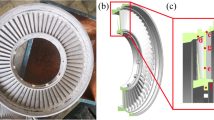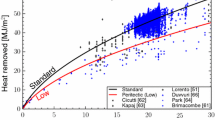Abstract
The deformation in superalloy investment casting under thermal-mechanical coupled stress results in significant waste of materials and energy. In order to accurately predict the deformation of castings, it is crucial to develop and apply mechanical models of both alloy and shell. The elastoplastic behavior of superalloy in a semi-solid zone is critical to the deformation during solidification. This study focuses specifically on the deformation of ring-to-ring castings with Ni-based superalloy K4169. To obtain the thermal-mechanical behavior of K4169 from solid region to semi-solid zone, physical simulated uniaxial compression is performed. The measured yield stress and plastic modulus are imported into the database for numerical simulation. Different thermal-mechanical models of both alloy and shell are compared. With elastoplastic model for alloy, considering the deformability of shell with elastic model, the maximum error is limited to 0.34 mm. Among groups of processing parameters, the deformation reaches the minimum when the initial temperature of alloy and shell are 1500 \(^{\circ }\)C and 900 \(^{\circ }\)C. The research on the semi-solid performance of the alloy and the development of thermal-mechanical models can provide theoretical insights for predicting deformation. Moreover, the research methodology holds promise for dimensional control of castings and can be transported to dimensional control problems upon solidification process with different kinds of materials and castings.














Similar content being viewed by others
References
Tamta K, Karunakar DB (2021) Development of hybrid pattern material for investment casting process: an experimental investigation on improvement in pattern characteristics. Mater Manuf Process 36(6):744–751. https://doi.org/10.1080/10426914.2020.1854471
Gill SS, Kaplas M (2009) Comparative study of 3D printing technologies for rapid casting of aluminium alloy. Mater Manuf Process 24(12):1405–1411. https://doi.org/10.1080/10426910902997571
Galles D, Beckermann C (2017) Prediction of distortions and pattern allowances during sand casting of a steel bracket. Int J Cast Met Res 30(3):133–147. https://doi.org/10.1080/13640461.2016.1262984
Donghong W, Yu J, Yang C, Hao X, Zhang L, Peng Y (2022) Dimensional control of ring-to-ring casting with a data-driven approach during investment casting. Int J Adv Manuf Technol 119(1):691–704
Cannell N, Sabau AS (2005) Predicting pattern tooling and casting dimensions for investment casting, phase II. Report, Edison Materials Technology Center (EMTEC)
Lewandowski M, Overfelt R (1999) High temperature deformation behavior of solid and semi-solid alloy 718. Acta Mater 47(18):4695–4710
Guo H, Chaturvedi MC, Richards NL (1999) Effect of boron concentration and grain size on weld heat affected zone microfissuring in Inconel 718 base superalloys. Sci Technol Weld Join 4(4):257–264. https://doi.org/10.1179/136217199101537761
Lu Y, Li M, Huang W, Jiang H (2005) Deformation behavior and microstructural evolution during the semi-solid compression of Al-4Cu-Mg alloy. Mater Charact 54(4–5):423–430
Afazov S, Becker A, Hyde T (2011) Fe prediction of residual stresses of investment casting in a bottom core vane under equiaxed cooling. J Manuf Process 13(1):30–40
Bathe, K-J (2006) Finite element procedures. Klaus-Jurgen Bathe
Labergère C, Long M, Badreddine H, Niane N, Grange D, Saanouni K (2021) Thermomechanical model for solidification and cooling simulation of Ni-based superalloy components. Int J Solids Struct 212:202–219
Panwisawas C, Gebelin JC, Warnken N, Broomfield RW, Reed RC (2011) Numerical modelling of stress and strain evolution during solidification of a single crystal superalloy. Adv Mater Res 278:204–209. https://doi.org/10.4028/www.scientific.net/AMR.278.204
Galles D, Lu J, Beckermann C (2019) Determination of pattern allowances for steel castings using the finite element inverse deformation analysis. Int J Cast Met Res 32(3):123–134. https://doi.org/10.1080/13640461.2018.1558562
Qiu F, Bu K, Song J-H, Tian G-L, Zhang X-D (2018) Dimensional control of nickel-based single crystal turbine blade investment casting by process control optimization. Int J Met 12(3):469-479
Galles D, Beckermann C (2017) Effect of sand dilation on distortions and pattern allowances during steel sand casting. Int J Cast Met Res 30(5):257–275. https://doi.org/10.1080/13640461.2017.1290909
Yan J, Chen L, Liao D, Lin H, Liu R (2004) Study on numerical simulation of casting thermal stresses based on FDM. Acta Mater Sinica 17(1):7–10
Behera MM, Pattnaik S, Sutar MK (2019) Thermo-mechanical analysis of investment casting ceramic shell: a case study. Measurement 147:106805. https://doi.org/10.1016/j.measurement.2019.07.033
Neto R, Duarte T, Alves JL, Torres F (2017) Experimental characterization of ceramic shells for investment casting of reactive alloys. Ciencia & Tecnologia dos Materiais 29(1):34–39
Sundararaman M, Mukhopadhyay P, Banerjee S (1988) Precipitation of the \(\delta \)-Ni3Nb phase in two nickel base superalloys. Metall Trans A 19(3):453–465
Lu Z, Chen Y, Miao K, Xu W, Liu T, Yang Q, Li D (2018) Microstructures and high-temperature strength of gel-casting Al2O3-based ceramic molds with coated aluminum additive. Int J Adv Manuf Technol 94(1):845–854. https://doi.org/10.1007/s00170-017-0930-9
Lu Y, Liu X, Lü K, Li Y, Liu F, Liu P (2021) Properties and fracture surface features of plaster mold reinforced with short polypropylene fibers for investment casting. Int J Met 15(2):700–709. https://doi.org/10.1007/s40962-020-00505-3
Kanka B, Schneider H (2000) Aluminosilicate fiber/mullite matrix composites with favorable high-temperature properties. J Eur Ceram Soc 20(5):619–623. https://doi.org/10.1016/S0955-2219(99)00260-5
Pattnaik S, Sutar MK (2022) Preparation and analysis of a hybrid ceramic shell for investment casting. Int J Adv Manuf Technol 122(5–6):2513–2527
Nawrocki J, Szeliga D, Kubiak K, Matysiak H, Motyka M, Ziaja W (2015) Influence of process parameters on cooling conditions in nickel base superalloy investment casting. Key Eng Mater 641:124–131. https://doi.org/10.4028/www.scientific.net/KEM.641.124
An LJ, Peirce A (1994) The effect of microstructure on elastic-plastic models. SIAM J Appl Math 54(3):708–730. https://doi.org/10.1137/s0036139992238498
Mandziej, ST (2005): In: Böllinghaus T, Herold H (eds) Testing for susceptibility to hot cracking on Gleeble\(^{\text{TM}}\) physical simulator, pp 347–376. Springer, Berlin, Heidelberg. https://doi.org/10.1007/3-540-27460-x_18
Funding
This work was financially supported by the National Key Research and Development Program of China (2020YFB1710100, 2022YFB3706803), the National Science and Technology Major Projects of China (J2019-VI-0004-0117), and the National Natural Science Foundation of China (51821001, 52090042, 52074183).
Author information
Authors and Affiliations
Contributions
ZD: alloy performance measurement, numerical simulation with different processing parameters, simulation data processing, and manuscript writing. DW: shell performance measurement, real production, and comparison. BG: numerical simulation with different mechanical models. JC: mechanical performance modeling. DS: guidance on experimental measurement and supervision of experimental parts. BS: guidance on numerical simulation and supervision of the whole research.
Corresponding author
Ethics declarations
Competing interests
The authors have no relevant financial or non-financial interests to disclose.
Additional information
Publisher's Note
Springer Nature remains neutral with regard to jurisdictional claims in published maps and institutional affiliations.
Rights and permissions
Springer Nature or its licensor (e.g. a society or other partner) holds exclusive rights to this article under a publishing agreement with the author(s) or other rightsholder(s); author self-archiving of the accepted manuscript version of this article is solely governed by the terms of such publishing agreement and applicable law.
About this article
Cite this article
Ding, Z., Wang, D., Guan, B. et al. Semi-solid plasticity and deformation control of superalloy investment casting. Int J Adv Manuf Technol 130, 3419–3429 (2024). https://doi.org/10.1007/s00170-023-12828-6
Received:
Accepted:
Published:
Issue Date:
DOI: https://doi.org/10.1007/s00170-023-12828-6




